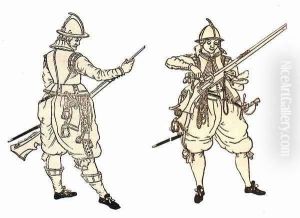Jacob de II Gheyn Paintings
Jacob de Gheyn II was a Dutch painter and engraver, whose work played a significant role in the transition from the 16th to the 17th century in Dutch art. Born in Antwerp in 1565, de Gheyn grew up in a family deeply involved in the art world; his father was a glass painter, and his brother would also become a painter. This environment nurtured his early interest in the arts, leading him to study under his father as well as under prominent artists such as Hendrick Goltzius in Haarlem.
De Gheyn is particularly known for his work in engraving and printmaking, areas in which he was highly innovative and influential. He moved to the Northern Netherlands, where he became part of the burgeoning Dutch art scene, contributing significantly to the development of the Dutch Golden Age of painting. De Gheyn's engravings covered a wide range of subjects, including portraits, landscapes, and religious themes. His precise and detailed style attracted a wide audience, and his prints were widely disseminated, influencing a generation of artists.
In addition to his engravings, de Gheyn was also a talented painter, though fewer of his paintings have survived. His works in this medium often reflect the same themes as his engravings, showcasing his interest in detail, nature, and the human figure. De Gheyn was particularly adept at capturing the intricate details of armor and weaponry, which made him a sought-after artist for military and aristocratic patrons.
De Gheyn's legacy is also marked by his contribution to the art of military and scientific illustration. He collaborated with Maurice of Nassau, Prince of Orange, on a drill manual entitled 'Exercise of Arms' for the infantry, which was groundbreaking in its detailed and systematic approach to military drills, and was illustrated with precise engravings by de Gheyn. This work had a lasting impact on military training in Europe.
Jacob de Gheyn II passed away in The Hague in 1629. His work remains highly regarded for its precision, beauty, and contribution to the Dutch Golden Age of art. Through his engravings and paintings, de Gheyn played a crucial role in the dissemination of Dutch artistic ideas and techniques across Europe, influencing not only his contemporaries but also future generations of artists.










